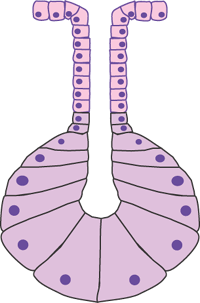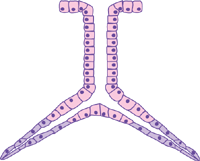Epithelia: Classification of exocrine glands
Exocrine glands are classified in the following way:
- Duct Structure
- SIMPLE - single unbranched duct (glands of large intestine)
- COMPOUND - branched duct (salivary glands)
- Shape of Secretory Units
- TUBULAR (alveolar) - (sweat glands)
- ACINOUS (acinar) - shaped like a grape (salivary glands)
- Mechanism of Secretion
- merocrine - product released by exocytosis ( most sweat glands). The most common type of secretion.
- holocrine- whole cell ruptures during release of product (sebaceous glands).
- A third type of secretion: apocrine was also once described, but these glands are in fact mostly merocrine.
The glands can either have serous, mucous or mixed serous and mucous secretion.
The ducts of glands often contain myoepithelial cells. These are contractile cells that lie betweeen the basement membrane and the epithelium of the ducts. Find out more in the muscle topic area

This is a simple tubular gland. In this type of gland, the lumen is straight (unbranched).

This is a simple acinar gland. In this type of gland, the secretory units are rounded - and the secretory portion looks rounded.

This is a simple branched tubular gland. Several secretory portions converge onto a single unbranched duct of wider diameter.

This is a compound branched tubular gland. In compound glands, the ducts are branched.



